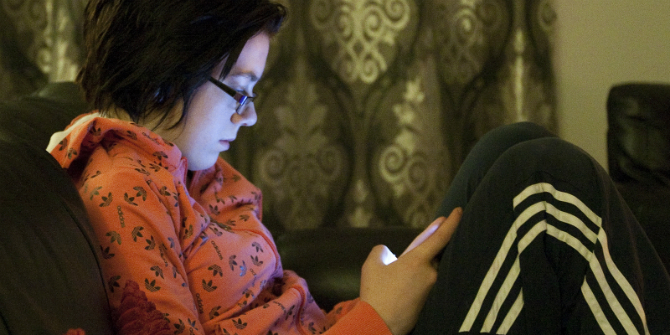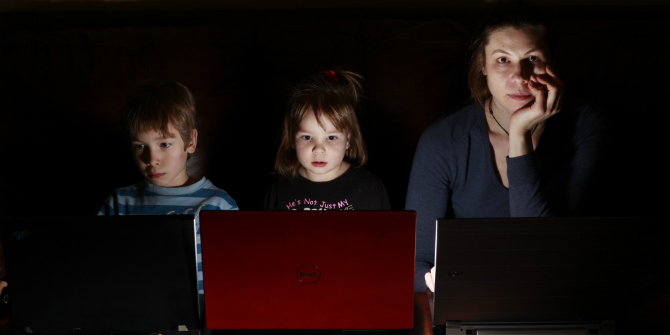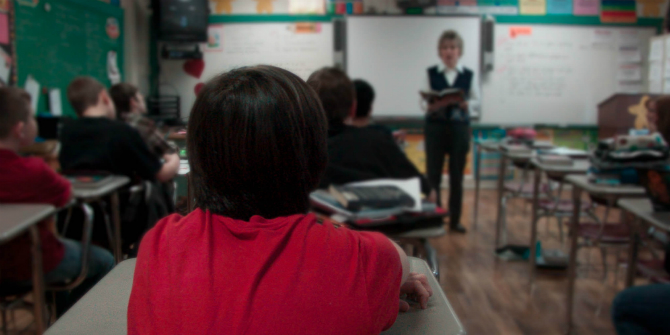 In this post, Rojin Vishkaie discusses her study of how teachers view emerging technology which assists with children’s emotional wellbeing. Her initial research shows that teachers envision a playful technology that can help children display their emotions in the classroom. Rojin is an assistant professor of human-computer interaction and interaction design. She received her PhD in computational media design, with a specialisation in human-computer interaction and interaction design from the University of Calgary. Rojin’s current research focuses on embodying the interaction between young children’s creativity and emerging digital media. [Header image credit: J. Baxter, CC BY-NC-SA 2.0]
In this post, Rojin Vishkaie discusses her study of how teachers view emerging technology which assists with children’s emotional wellbeing. Her initial research shows that teachers envision a playful technology that can help children display their emotions in the classroom. Rojin is an assistant professor of human-computer interaction and interaction design. She received her PhD in computational media design, with a specialisation in human-computer interaction and interaction design from the University of Calgary. Rojin’s current research focuses on embodying the interaction between young children’s creativity and emerging digital media. [Header image credit: J. Baxter, CC BY-NC-SA 2.0]
“If I could have an app or companion or something, it would be like the Inside Out animated movie and a child would touch it and choose their feelings based on angry, worried, happy, joy to illustrate it, and that immediately would come to me somehow, and then I would have a document daily to know how they are feeling.” (Primary school teacher)
Prior research has recognised daily classroom life (for children and others) as an emotional environment where interest, enjoyment, curiosity, shame, pride, anxiety, confusion, boredom, engagement, coping, and motivational resilience reappear pervasively, frequently, and intensely. In The Second Self, Turkle explores, “how the computer affects our awareness of ourselves, of one another, and of our relationship with the world”.
Similarly, in Affective Computing, Picard discusses how affective technology are “systems with the ability to recognise and express emotions” and have the potential to display what is felt inside and display the emotions to the outside world (e.g. the classroom). It is further argued that future emotion communication technology enables personalised learning opportunities for children, especially for those with emotional and behavioural problems (e.g. autism). Despite digital technology’s increasing relevancy in daily life, there is little research on how they can be used to help children perceive and express their emotions, particularly in classroom environments.
What did we do to date?
Initially, we considered interviewing children before exploring the design of our wristband, but the occasional difficulties that early elementary children had in identifying their emotions verbally in our pilot interviews resulted in a focus on learning about teachers’ perceptions of children’s emotions in the classroom. We then interviewed a group of early elementary teachers to gain insights into:
- Teachers’ perceptions of the role that technology currently plays in improving children’s emotional wellbeing.
- Teachers’ vision of the design of a child-emotion communication technology that provides support to children.
What did we learn from teachers?
From our initial study with teachers, we observed that they believed they could benefit from a mediated ’emotion companion’ for their students, and that they themselves could learn from children’s interaction with emotion companions. For the teachers, having such a companion means they could initiate more emotionally effective communications and interactions with their students. This led us to prototype the ways in which a child-emotion companion could become children’s emotional support and friend in the classroom.
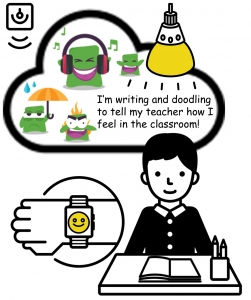
What is the Child-Emotion Companion?
Inspired by the teddy bear, a classic children’s toy, and the design of a playground, our Child-Emotion Companion prototype captures self-reporting data through a wristband with sensors that sends information through a wireless network to beacons mounted in a classroom. Colour-coded emotions (e.g. joy is yellow, sadness is blue, anger is red, disgust is green, and fear is purple) for all aggregated emotions of the children (e.g. the joy of problem solving) are projected as an ambient light (e.g. yellow), and through an art piece (e.g. sunshine painting) on the walls, floor, and ceiling of the classroom, or audio material (e.g. music). Also, the wristband can be personalised by the child wearer using various stickers and even their own audio materials, such as sounds and music to represent the manifestations of their emotions. We believe this can encourage more children to use the wristband as it allows for more personalised experience and playful interaction (See figures 1 and 2).
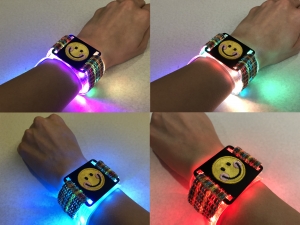
What do we envision to be the effects of our digital technology?
Our concept provides an alternative method for advancing children’s emotional wellbeing through the design of communication technology and art as a visual manifestation of emotion. However, we envision this intervention as relying on a combination of technical and social components to contribute to conversations regarding how emotion-sensing technology can be used to improve educational experience and wellbeing in the classroom and assist with emotional and behavioural problems. We further argue that emotions have a key impact on essential cognitive processes, which constitutes the importance of exploring how children and teachers interact with this technology to support their interpersonal connections.
While there is a growing trend of data collection of personal information which raises serious concerns about children’s digital profiling, we recognise that our intervention-based approach to collecting information about children’s emotional state may not be immediately and universally impactful. Although Children’s Online Privacy Protection Act (COPPA) provides some security measures for young children in the USA, they may not be as secure in other regions. This provides a limitation for our current concept.
What will we do next?
We have the following future goals:
- Examining how our preliminary designs are received by both children and teachers in the classroom.
- Safeguarding privacy and safety risks involved in children’s curating and sharing of personal information.
- Examining issues ranging from effective communication of emotion to the impact of an aesthetic and playful shift from a common to an interactive classroom.
- Building skills while reducing the stigma about children’s emotional and cognitive challenges.
- Engaging community partners, such as elementary to high schools, universities, museums, tech-shops, and makerspaces to conceptualise the integration of wearable technology and methodological approaches to the curriculum.
We hope our current and future planned work will encourage anyone interested in parenting, children, and digital media to consider addressing the current limitations of emotion perception and expression through wearable technology, and the protection of children’s personal information.
This post gives the views of the author and does not represent the position of the LSE Parenting for a Digital Future blog, nor of the London School of Economics and Political Science.


